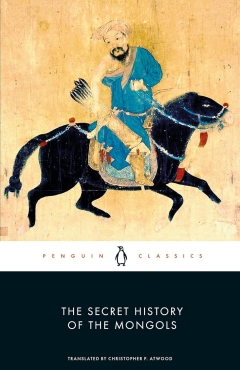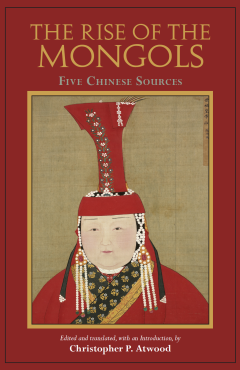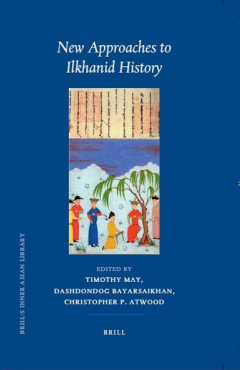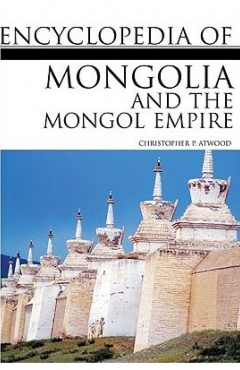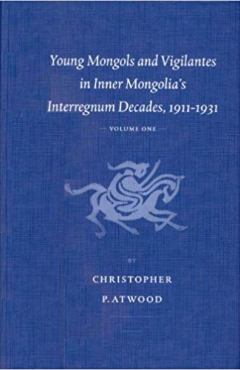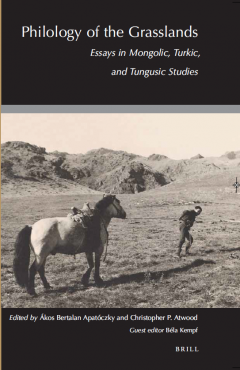After getting my AB from Harvard University (1986), where I was introduced to Mongolian and Chinese studies by Joseph Fletcher and Francis W. Cleaves, I spent two years in Inner Mongolia, traveling and taking classes in the Mongolian language and literature department at Höhhot’s Inner Mongolia Normal University.
I received my PhD from Indiana University’s Central Eurasian Studies Department, where I worked with György Kara, Lynn Struve, Elliot Sperling, and Jeff Wasserstrom. Before coming to Penn, I taught for two decades at Indiana University, serving as department chair and interim director of the Center for Languages of the Central Asian Region.
My approach to history can be summed up by Daryl Zero:
"When you go looking for something specific, your chances of finding it are very bad. Because of all the things in the world, you’re only looking for one of them.
"When you go looking for anything at all, your chances of finding it are very good. Because of all the things in the world, you're sure to find some of them."
and
"I can't possibly overstate the importance of good research. Everyone goes through life dropping crumbs. If you can recognize the crumbs, you can trace a path all the way back from your death certificate to the dinner and a movie that resulted in you in the first place. But research is an art, not a science, because anyone who knows what they're doing can find the crumbs, the wheres, whats, and whos. The art is in the whys: the ability to read between the crumbs, not to mix metaphors. For every event, there is a cause and effect. For every crime, a motive. And for every motive, a passion. The art of research is the ability to look at the details, and see the passion."
PhD, Indiana University, Bloomington, 1994
My research has centered on the relation of culture (especially history writing and religion) and the formation of political power among the Mongols.
My first major research project was on twentieth century Mongolian nationalism in Inner Mongolia and its interaction with Chinese state-building in the late Qing and Republican period. My current major projects include: 1) the multi-ethnic and multi-lingual historiography of the Mongol Yuan dynasty; 2) the Mongol empire, its religious and personnel policy, and the “early modern.”
Other topics I have written on and continue to work on include the social history of mobile pastoralism with a focus on Mongolia in the Qing period, and using philological methods to read “against the grain” of Chinese sources and shed light on the institutional history of pre-Mongol and pre-Turkic Inner Asia.
But perhaps the best way to give a sense of my interests (present and for the future) is to list topics that I've thought it would be great to read about or, if some student with the appropriate interests is so inclined, to direct a Master's thesis or Dissertation about. These aren't topics I'm currently working on, at least not directly, but they're topics I think are important and that I've wondered about, and maybe have a file in my mind, or on my computer, about.
Of course students at other universities are free to "steal" these topics. There is so very much to be done in Mongolian studies, and the hands available to do it are so few, that the "keep your cards close to your chest or you'll get scooped" competitive ethos of other fields hardly applies.
Environmental History
Marmots and Mongols: two millennia of image, plague, hunting, and just plain good eating: explore the multifaceted human marmot relations in Mongolia, including the marmot in Mongolian literature, how rodent eating has shaped the image of the Mongols, and more.
Ordos: An Ethno-Environmental History
Political History
The Azha (Toyogon) Khanate in Kokenuur: First Empire of the Tibetan Plateau
The Rou-Ran and the Rise of Mongolia’s Second Steppe Empire, OR The Rou-Ran: Mongolic Precursors of the Türk Empire.
Nurhaci and Cinggis: a Comparative study of imperial foundings on the Outer Frontier
The Great Break: Ambition, Activism, Inflation, and Rebellion in Leftist Mongolia, 1928-1932.
The Marshal: The Life and Times of Mongolia's Dictator Choibalsang, 1895-1952
De-Stalinization in Mongolia: in every Communist country where it occurred, de-Stalinization had a profound effect particularly on culture. What was the effect in Mongolia?
Ethnic History
Golden Khans and White Tatars: The Jin Dynasty in Inner Mongolia, 1125-1225
Drive to the East: The Kazakh Migrations to Junggaria, Bayan-Olgii, Aksay, and Tsaidam, 1750 to 1950.
Scorpions in a Bottle: The Oyirat Conquest of Kokenuur and the Tibetan Nomads’ Ruthless Revenge, 1580 to 1880.
Bannerfolks in Xinjiang, 1750 to 1950: From Pro-Qing Loyalists to Pro-Soviet Leftists. Mongols, Shibe, Daurs, Ewenkis and how they formed communities and negotiated the perils of Chinese-Muslim conflict
Social and Economic History
Barbarians, Caitiffs, and Stinking Tartars: Chinese Slurs for Northern Nomads, from the Han to the Republic
Naming Revolutions among the Nomads: Eight Centuries of Personal Names in Mongolia
Partner Merchants in Shanxi, Höhhot, and Mongolia: use both Mongolian archives and local histories to trace the history of firms like Dashengkui as both local heroes and hated exploiters. The frog on land, the frog in water
Funding the Mongolian Government, vol. 1, 1750 to 1950, vol. 2, 1950 to the Present. You don’t know anything about a government until you understand 1) How it’s paid for; and 2) what it spends its money on. This is a history of Mongolian Budgets, corvee, taxations, public and foreign debt, and public spending.
Feudal Freedoms and Socialist Traditions: Marriage in Mongolian Society, 1850 to 2000.
Population and Prices in a Pastoral Nation: 1750-1940. Explore the interrelation of human and animal demography with price dynamics in a Mongolia tied to world markets. Mongolia's archives have by far the most detailed demographic record of any pastoral nomadic people anywhere in world history. There's also been an ongoing publication of very fine-grained data from the entire 1926 census.
Disciplining Mongolia: Public Schools and Conscription as Workshops of the Mongolian Modern, 1921 to 1960.
Making and Breaking of the Mongolian Working Class, 1921 to 1992. How the socialist government of Mongolia created a “national” working class and how the world neoliberal movement destroyed it.
Liturgies of Every Day Life: The Jang Aali Text as Genre of Nation Making in Inner Mongolia, 1900 to 2015. How the Jang Aali genre from Lubsang-Choidan to the Present has served as a model from constructing nationalized lives.
The Mongolian immigrant community in the United States: trace the formation of a complete immigrant community from 0 in 1989 to 25K in 2018.
History Writing and Intellectual History
Conquerors and Genres: How New Song-era Historical Genres—Buddhist annals, Outline and Details Chronicles, and the Prosopographical History—Were Used to Write Yuan History
Chinese Historiography in Qing Mongolia: Dharma Güüśi, Raśipungsuq, and the Inner Mongolian echoes of Qing ideology.
How the Secret History of the Mongols Became Scripture: In 1945, the Secret History was essentially unknown in Mongolia. By 2010, the Mongolian government was asking every household to keep a copy in an honored position. How did this happen and what does it tell us about the process of textual canonization?
Religion
Local Cults and the Synecdochic Imagination of the Mongolian Nation: Inspired by Rian Thum’s Sacred Routes of Uyghur History, and using rituals (oboo, Chinggis Khan, mountain, fire, and more) to show how each Mongol banner was imagined as a complete reproduction of all of Mongolia
The Fifth Dalai Lama and the Mobilization of Mongol Sectarianism: How the Fifth Dalai Aimed to create a purely Gelugba Mongolia, and his view of the role of Mongolia as a perpetual subordinate to a new Tibetan empire.
Chinggis Khan in Tibetan and Mongolian Buddhist Ritual: Explore the interaction of Tibetan views of the Mongols with Mongol views of Chinggis Khan
Kalmyk Buddhist Rituals from the Cossacks to America: how does isolation affect Buddhist ritual practice?
Islam among the Khotongs. After over two hundred years of isolation, a small community of Mongolian-speaking people claiming Uyghur and Islamic ancestry began to be revisited by Fethulla Gulen missionaries seeking to reclaim them for orthodox Islam. So how did they react?
Being Buddhist in Modern Mongolia: A Bruce Privratsky style study of how Mongolian Buddhism survived the years of persecution, and how that persecution shaped practice today.
Literature
The Four Seasons in Mongolian Poetry: how Mongols localized genres based on very difference weather.
The Dharma among the Birds: The Moon Cuckoo Story in Tibetan, Mongolian, and Western Literature
S. Udwal and the Mobilization of Mongolian Women in the Socialist Era.
Moscow Nights: Mongolians living, learning, yearning, loving, and lamenting in and for Russia (like a version of McGuire's "Red at Heart" but with Mongolia). Or a similar one about Inner Mongolia and Japan, like Boyd's Faith, Race, and Strategy, only more literary and Mongol-centered
One Language, Two Canons: How Damdinsuren, Erdenitogtahu and their friends created literary canons in Mongolia and Inner Mongolia from the 1930s to the 1950s. This would also be a study of intellectual interaction and divergence between Mongolia and Inner Mongolia.
Great Wall of China;
Mongol Century;
Introduction to Inner Asian Civilization;
The Secret History of the Mongols;
Social History of Inner Asian Nomadism;
Historiography of the Mongol Yuan Empire;
Religion and Ethnicity in Inner Asia;
Ordos Documents.
I have been visiting scholar at the Institute for Advanced Study (Princeton), Peking University, Minpaku, Inner Mongolia University, and Inner Mongolia Normal University, and served as academic consultant for the History Department of Mongolia National University. Another major area of interest is developing materials for academic and popular teaching about Inner Asia and Mongolia. Publications in this area includes the Encyclopedia of Mongolia and the Mongol Empire, and the translation of Chinese and Mongolian source for class use. I also hope to complete a Source of Mongolian Tradition reader (with Johan Elverskog) and a new translation of the Secret History of the Mongols.


